| home > 2010 financial > statutory > Nota integrativa |
home > 2010 financial > statutory > Notes to the Parent Company
financial statements
Notes to the Parent Company financial statements
1) Activity of the company
Rai-Radiotelevisione italiana SpA (hereinafter Rai) is exclusively assigned the public service broadcasting of radio and television
programmes using any technical media.
Tangible assets at 31 December 2010 amount to 321,715 thousand euros, showing an overall net decrease of 12,139 thousand
euros on 31 December 2009, comprising the balance between increases of 48,981 thousand euros (106 thousand of
which deriving from the merger of RaiSat) and decreases of 61,120 thousand euros, as detailed in Schedule 2.
Following authorisation by the Italian Ministry of Communications, the company may enlist the aid of subsidiaries for activities
relating to the performance of the pertinent services.
Rai's operations must be conducted in compliance with the applicable regulations in force contained in Law 103 of 14 April
1975 ("New regulations governing radio and television broadcasting"), Law 223 of 6 August 1990 ("Regulation of the public
and private radio and television system"), the "Measures governing the concession holder for the public radio and television
broadcasting service" issued with Law 206 of 25 June 1993 and subsequent amendments, Law 249 of 31 July 1997 on the
"Establishment of the Communications Authority and regulations governing telecommunications and the radio and television
system" and Law 112 of 3 May 2004 ("Regulations establishing principles for the organization of the radio and television
system and Rai-Radiotelevisione Italiana SpA, as well as granting authority to the Government to issue a consolidated radio
and television law"). With Legislative Decree 177 of 31 July 2005 approval was given to the" Consolidated Law governing
Radio and Television", which was amended and renamed "Consolidated Broadcasting Law" by Legislative Decree 44 of 15
March 2010, incorporating additional clauses, amendments and cancellations necessary for the co-ordination of the services
or their proper implementation. The Consolidated Law also contains the provisions of Law 112/04, relating to the radio and
television general public service and, consequently, articles 3 and 5 of Law 206/93 not repealed by Law 112/04.
The general public radio and television service concession is assigned to Rai until 6 May 2016, on the basis of the Consolidated
Law governing Radio and Television, issued with article 49 of the Legislative Decree 177 of 31 July 2005.
Article 45 of the same Consolidated Law envisages that the general public radio and television service be provided by the
concession holder on the basis of a National Service Agreement lasting three years, entered into with the Italian Ministry of
Communications, identifying the rights and obligations of the concession holder.
The new service agreement for 2010-2012 was entered into between the Ministry of Economic Development and Rai on 6
April 2011.
The rationale underlying the above regulatory framework lies in the public interest functions entrusted to the concession holder.
Under these regulations, Rai has special institutional characteristics and operating constraints, in addition to the specific obligations
undertaken with the Service Contract.
2) Introduction
The Parent Company financial statements at 31 December 2010 are prepared in accordance with the relevant provisions of
the Italian Civil Code. They are supplemented with annexes featuring the reclassified statements comprised of tables for the
analysis of the balance sheet and income statement, and of cash flows.
The financial statements are expressed in euros, without decimals; the Notes to the financial statements and the related detailed
Schedules are stated in thousands of euros.
With regard to the merger by incorporation of RaiSat SpA, which took place during the year, detailed Schedules 41 and 42
have been drawn up to disclose the information required by legislation for the first financial statements following the merger.
Rai's financial statements have been audited by PricewaterhouseCoopers SpA.
3) Accounting policies
Before examining the individual items, we have provided an overview of the main accounting policies used in drafting the
financial statements, which were adopted from the perspective of the Company as a going concern and comply with the
provisions of Articles 2423 et seq. of the Civil Code. Such policies are unchanged from those applied in the preceding
year. There are no exceptional cases requiring derogation from the requirements under Article 2423-bis et seq. of the
Civil Code.
a) Industrial patents and intellectual property rights:
The acquisition and production costs of programmes, composed of external costs that can be allocated directly to each
project and the cost of internal resources used to create programmes, are recorded according to the following criteria:
1) costs for repeat-use television productions are capitalised under intangible assets and, if such productions are usable
at year-end, are carried under industrial patents and intellectual property rights and amortised on a straight-line basis
over the period of their estimated useful life. If such programmes are not yet usable at year-end, the costs are carried
under intangible assets under development and payments on account.
The objective difficulty of establishing an appropriate correlation between advertising revenues and licence fees and
the amortisation of the rights, which is further complicated by the many ways in which they can been used, has prompted
Rai to designate three years as the useful life of repeat-use programmes, represented by TV series, cartoons and
comedies, and four years for that of library exploitation rights for football events.
Costs for concession rights with a shorter duration are amortised over the period they are available.
In addition, an impairment provision has been established for programmes for which transmission or re-broadcasting
is at risk.
2) Costs for immediate-use television programmes are expensed in a single year, which is normally that in which they are
used. More specifically:
• News, light entertainment and all radio programming. Costs are expensed in the year in which they are incurred, which
is normally the year in which the programmes are broadcast.
• Sports events. Costs are booked to the year in which the event takes place.
•Documentaries, classical music and drama. Costs are charged against income in a single amount at the time the programmes
are ready for broadcasting or the rights are usable.
b) Software licences are carried with industrial patents and intellectual property rights net of amortisation and are amortized
over three years from the year they enter service.
c) Costs incurred for the construction of the digital terrestrial network are capitalised under intangible assets net of amortisation
and amortised on a straight-line basis over the forecast period of use from the date the service is activated.
d) Trademarks are amortized over ten years from the year they enter service.
e) Deferred charges are carried under other intangible assets net of accumulated amortisation. They regard improvements to
leased or licensed property and accessory charges on loans. Amortisation for leasehold improvements is determined on
the basis of the shorter of the residual duration of the related contracts and the estimated period of benefit of the costs, calculated
using amortisation rates which reflect the rate of economic deterioration of the relative assets. Accessory charges
on loans are amortised in relation to the duration of the loan.
f) Tangible fixed assets - which are shown net of accumulated depreciation - are recorded at cost, increased by internal
personnel costs incurred in preparing them to enter service, and revaluations pursuant to laws. The costs of fixed assets as
determined above are depreciated in accordance with Article 2426 (2) of the Civil Code. Ordinary maintenance costs are
expensed in the year in which they are incurred.
g) Equity investments are carried at purchase cost adjusted in the event of permanent impairment in value. The value of companies
with negative shareholders' equity is set at zero and Rai's share of the deficit is specifically provided for under the
provisions for risks and charges. Adjustments for permanent impairment are reversed in the event that such impairment is
subsequently recovered due to sufficient operating earnings by the investee company.
h) Fixed-income securities carried as non-current financial assets are valued at purchase cost. Positive or negative differences
between purchase cost and redemption value are taken to income in the amount accruing for the year.
i) Non-current assets which, at the balance sheet date, have suffered a permanent impairment in value, are carried at the
lower value. Should the reasons for the writedown made in previous years no longer apply, the assets are revalued within
the limits of the amount of the writedown.
j) Other securities carried under current financial assets are valued at the lower of purchase cost - determined as the
weighted average cost - and estimated realisable value, which is given by market value.
k) Inventories of raw materials, supplies and consumables (technical materials) are valued at purchase cost, which is determined
on the basis of weighted average cost, written down taking account of market trends and estimated non-use due to
obsolescence and slow turnover. Inventories of items for resale (relating to periodicals and book publishing) are carried at
the lower of purchase cost, which is determined on the basis of weighted average cost, and estimated realisable value as
determined by market prices.
l)Accrued income and prepaid expenses, and accrued expenses and deferred income, are recorded on an accruals basis
for the individual entries.
m) Provisions for pension and similar liabilities, which comprise the provision for supplementary staff severance pay, the social
security benefits provision and the company supplementary pension fund, are made in accordance with collective bargaining
agreements. The Company supplementary pension fund is valued on the basis of an actuarial appraisal.
n) The provision for taxes includes probable tax liabilities arising out of the settlement of tax disputes and includes deferred
tax liabilities calculated on timing differences which have resulted in lower current taxes. Deferred tax assets arising from
charges which are tax-deductible on a deferred basis and from tax losses are taken up under Current Assets caption 4 ter
("Deferred tax assets") if there is reasonable certainty that they will be recovered in the future.
o) Other provisions for risks and charges include provisions to cover specific losses or liabilities, the existence of which is
certain or probable, but the amount or date of occurrence of which is uncertain. They are set up on a case-by-case basis
in relation to specific risk positions and their amount is determined on the basis of reasonable estimates of the liability that
such positions could generate.
p) The provision for staff severance pay is determined in compliance with applicable law and labour contracts. It reflects the
accrued entitlement of all employees at the balance-sheet date net of advances already paid.
q) Payables are shown at nominal value; receivables are carried at estimated realisable value, net of bad debts provision as
determined on the basis of a case-by-case assessment of the solvency risks of the individual debtors.
r) Payables and receivables denominated in currencies other than the euro - with the exception of hedged positions,
which are valued at the rate applying to the financial instrument - are recorded at the exchange rates applying at
the balance sheet date. Profits and losses ensuing from such conversion are taken to the income statement as components
of financial income or expense. Any net profit is taken to a specific non-distributable reserve until the profit
is realised.
s) Payments on account include advances paid by customers for services that have not yet been performed.
t) Costs and revenues are taken to the income statement on a consistently applied accruals basis.
u) Dividends are taken to income in the year in which they are received.
v) Income taxes are recorded on the basis of an estimate of taxable income in conformity with applicable regulations, taking
account of deferred tax positions. The tax liability to be settled on presentation of the tax declaration is carried under taxes
payable, together with liabilities relating to taxes already assessed and due.
The Company has opted for the Group to be taxed on a consolidated basis and accordingly, as the consolidating entity,
attends to all requirements connected with the settlement of IRES tax for all companies within the consolidated taxation
arrangement.
The procedure for the consolidation of the Group's taxable amounts is regulated by a specific agreement between the
Parent Company and the subsidiaries.
The fundamental standards that regulate this agreement are neutrality (absence of negative effects on the single companies),
proportionality in the use of losses and their integral remuneration on the basis of the rate of IRES in force at the time
of effective use, offsetting the incomes booked.
w) In order to hedge interest rate and exchange rate risk, the Company uses derivative contracts to hedge net exposures arising
from specific transactions. Interest differentials to be collected or paid on interest rate swaps are taken to the income
statement on an accruals basis over the duration of the contract. Accrued interest differentials that have not been settled
at the end of the year or which have been settled before they actually accrue are taken to accrued income and prepaid
expenses, or accrued expenses and deferred income, as the case may be. Derivative contracts hedging exchange rate
risks are used to cover contractual commitments in foreign currencies and entail adjusting the value of the underlying item.
The premium or discount arising from the differential between the spot and future exchange rates for hedging transactions
carried out via future acquisition of value and premiums paid in relation to options is taken to the income statement over
the duration of the contract.
If the market value of derivatives contracts, which do not fully qualify for hedge accounting, is negative, a specific risk
provision is set up for this value.
x) Collections are recorded by bank transaction date; for payments account is likewise taken of the instruction date.
4) Parent Company balance sheet
Assets
Non-current assets
Intangible assets
This caption includes the cost of non-physical factors of production with lasting utility, net of amortisation and writedowns
in the event of permanent impairment of value.
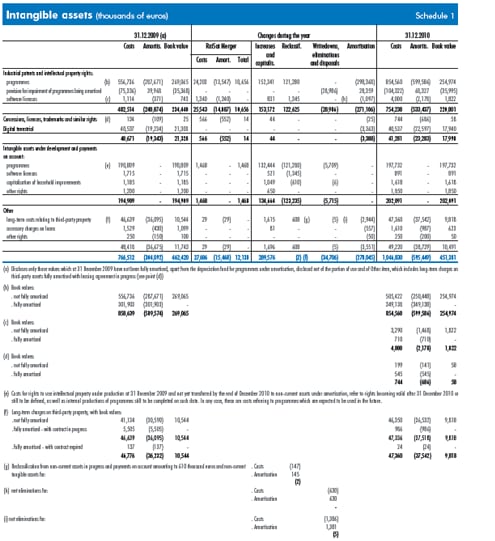
Industrial patents and intellectual property rights. As indicated in Schedule 1, they amount to 220,801 thousand euros,
as follows:
• 218,979 thousand euros for the cost of television programmes available for use, and compared with the figure as at 31
December 2009, shows a net decrease of 14,718 thousand euros. This decrease is represented by the balance between
the increase determined by the merger by incorporation of RaiSat (10,656 thousand euros), new assets for 273,621 thousand
euros (of which 121,280 thousand euros transferred from non-current assets under development and payments on
account for rights that became available during the year), a writedown against the risk of non-transmission and/or repeatability
of certain programmes amounting to 28,986 thousand euros and the amortisation charge for the year of 270,009
thousand euros;
• 1,822 thousand euros refers to software licences, which amounted to 743 thousand euros as at 31 December 2009.
This value is represented by the balance between new assets for 2,176 thousand euros (of which 1,345 thousand euros
transferred from non-current assets under development and payments on account for products that became available during
the year) and the amortisation charge for the year of 1,097 thousand euros.
As regards television programmes available for use, the overall sum, gross of the writedown, is broken down between:
• rights to television programmes owned or held under unlimited-term licences amounting to 218,500 thousand euros (at
31 December 2009: 221,868 thousand euros);
• rights to television programmes owned or held under fixed-term licences amounting to 36,474 thousand euros (at 31
December 2009: 47,197 thousand euros).
Overall investments in television programmes made in 2010 amount to 284,785 thousand euros, including 132,444 thousand
euros in programmes which are not yet available at 31 December 2010, which are carried under non-current assets
under development and payments on account.
Analysing investments by type, at 31 December 2010, 235,852 thousand euros was invested in fiction programmes (series,
miniseries, TV movies, soap operas etc), 11,774 thousand euros in documentaries, 17,444 thousand euros in cartoons and
comedy programmes, 10,150 thousand euros in football libraries and 9,565 thousand euros in other categories.
Concessions, licences, trademarks and similar rights. The items, which is stated net of accumulated amortisation, includes
costs incurred on the acquisition of licences for digital terrestrial frequencies, and own trademarks. They total 17,998
thousand euros, of which 17,940 thousand euros relating to digital network frequencies.
Non-current assets under development and payments on account. The item amounts to 202,091 thousand euros,
including:
• 197,732 thousand euros for the cost of television programmes which are not yet available, and therefore not subject to
amortisation, and compared with the figure as at 31 December 2009, showing a net increase of 6,923 thousand euros,
as indicated in Schedule 1. Specifically, the aforementioned increase is represented by the balance between the increase
determined by the merger by incorporation of RaiSat (1,468 thousand euros), increases for new assets (132,444 thousand
euros) and decreases for items transferred to Industrial patents and intellectual property rights in that they relate to productions
and/or purchases which became usable during the year (121,280 thousand euros) and eliminations for 5,709
thousand euros;
• 891 thousand euros refers to software licences and, compared with the figure as at 31 December 2009, shows a net
reduction of 824 thousand euros. The aforementioned increase is equal to the balance between increases for new assets
(521 thousand euros) and decreases for items transferred to Industrial patents and intellectual property rights in that they
relate to products that became usable during the year (1,345 thousand euros);
• 1,850 thousand euros refers to the cost to purchase options on agreements for the commercial exploitation of products held
in football libraries and, compared with the figure as at 31 December 2009, with a net increase of 650 thousand euros;
• 1,618 thousand euros refers to alterations and improvements underway on property under leasehold or concession and,
compared with the figure as at 31 December 2009, shows a net increase of 433 thousand euros;
For television programmes that have not yet become available, the total of 197,732 thousand euros includes:
• 151,957 thousand euros for television programmes owned by the Company that were not ready at 31 December 2010
or for which usage rights began after 31 December 2010 (at 31 December 2009: 150,767 thousand euros);
• 45,775 thousand euros regarding third-party television programmes held on fixed-term licence beginning after 31
December 2010 (at 31 December 2009: 40,042 thousand euros).
Other intangible assets. The amount of 10,491 thousand euros includes:
• 9,818 thousand euros for costs incurred, net of accumulated amortisation, on alterations and improvements to property
under leasehold or concession (at 31 December 2009: 10,544 thousand euros);
• 623 thousand euros for costs incurred during the year, net of accumulated amortisation, on stand-by loans with a duration
of three years, to be broken down throughout the loan period (at 31 December 2009: 1,099 thousand euros);
• 50 thousand euros for the purchase of a right to the first negotiation and option on the broadcasting of football matches,
net of amortisation calculated over the concession period (at 31 December 2009: 100 thousand euros).
Tangible assets
These comprise the costs and related revaluations of tangible fixed assets with a useful life of several years that are owned by the
Company and used in operations. They are carried net of standard depreciation and writedowns for lasting value impairments if any.
The standard depreciation rates applied are listed below:
• Buildings and light structures
- offices in industrial buildings
3%
- other industrial buildings and roads
6%
- light structures
10%
• Plant and machinery
- general and radio technical plant
12,5%
- transmission and television plant
19%
- recording plant and fitted vehicles
25%
• Industrial and sales equipment
19%
• Other assets:
- standard equipment
19%
- office furniture and equipment
12%
- electronic office equipment
20%
- transport vehicles
20%
- motor cars, motor vehicles and the like
25%
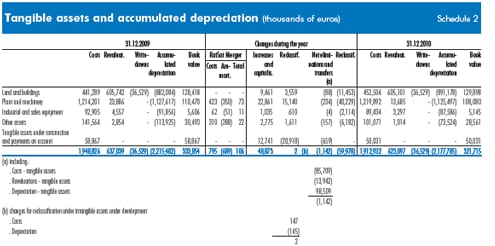
It should be noted that new tangible assets recorded, which reflect investments made in the year, comprise 5,924 thousand
euros for the capitalisation of the cost of internal personnel engaged in the construction of buildings, plant and machinery.
As regards disclosure of financial lease transactions it should be noted that since 2004 only the building located in Aosta was
acquired under this type of contract, to serve as the regional headquarters for Valle d'Aosta. The statements required under article
2427 (22) of the Civil Code, referred to in Document 1 of the Organismo Italiano di Contabilità (Italian Accounting Board),
showing the effects on the balance sheet and the income statement of the so-called financial method, are presented hereunder.
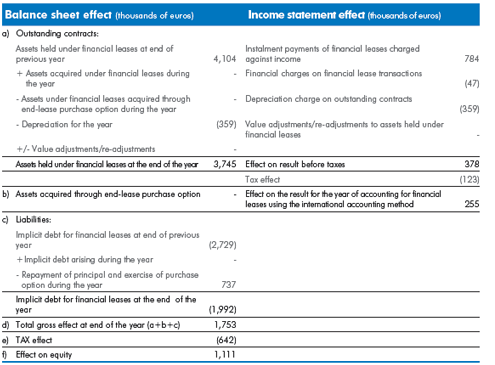
The gross value of revaluations recorded under non-current tangible assets is reported below, listed according to the applicable
regulations:
• 45,153 thousand euros gross in implementation of Law 576 of 2 December 1975 and Law 72 of 19 March 1983, the
purchase cost of which was 55,979 thousand euros. This comprises property acquired by 31 December 1946, the gross
value of which, amounting to 430 thousand euros, includes revaluation pursuant to Law 74 of 11 February 1952;
• 57,010 thousand euros gross in implementation of Law 413 of 30 December 1991;
• 520,934 thousand euros gross in implementation of Decree Law 263 of 29 April 1994, the effects of which were ratified
by Law 650 of 23 December 1996.
Non-current financial assets
These represent the cost of durable financial investments and related revaluations, net of any writedowns described in the
comments on the individual items.
Equity investments: these amount to 307,213 thousand euros and include investments in shares or other forms of equity in
companies, including consortiums. They are reported in the balance sheet under separate headings arranged by decreasing
levels of ownership.
The components of the value of equity investments, their distribution among the individual investee companies and transactions
during the period are detailed in Schedule 3. Schedule 4 shows the list of investments in subsidiaries and associated
companies pursuant to article 2427, item 5, of the Civil Code.
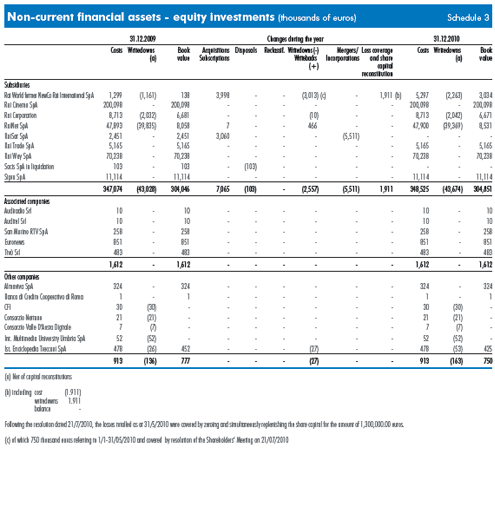
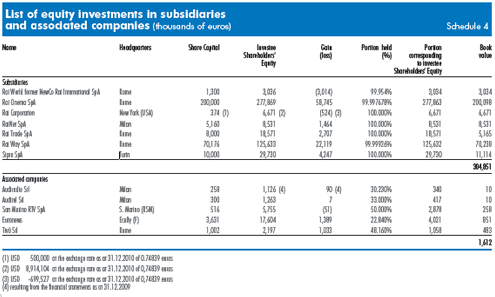
The following section discusses the more significant developments in investee companies and the consequent impact on the
Rai financial statements:
Equity investments in subsidiaries
•Rai World SpA formerly NewCo Rai International SpA (99.954% Rai): the share capital of 1,300 thousand euros is
represented by 1,300,000 shares with a par value of 1 euro each. The extraordinary shareholders' meeting held on
22 July 2010 resolved the coverage of the losses totalled at 31 May 2010 amounting to 1,911,840.66 euros, with the
zeroing of the share capital of 1,300,000 euros and payment by the shareholders, in proportion to the shares owned
until then, of the additional sum of 611,840.66 euros. At the same time, the replenishment and increase of the capital
to the amount of 1,300,000 euros was resolved, with the issue of 1,300,000 new shares with a par value of 1 euro
each. Rai subscribed to these shares for a total of 1,299,402 euros, with the remaining 598 euros worth of shares
going to Rai Trade. During the meeting held on 21 July 2010, Rai's Board of Directors resolved the performance of an
intervention on the capital in favour of the company, amounting to 3,410,271.21 euros, of which 1,910,961.21 for the
replenishment of the capital, as mentioned earlier, and 1,499,310 euros for future capital increase. This last payment
was made on 15 September 2010, with Rai Trade also participating with the amount of 690 euros. During the meeting
held on 22 December 2010, Rai's Board of Directors resolved a further payment for future capital increase, totalling
2,500,000 euros, to be made by both shareholders in their respective percentages, with said amount to be deposited
on the corresponding current account, available from 22 December 2010. The company ended 2010 with a loss of
3,014 thousand euros, 750 thousand euros of which has already been covered. For the remainder, the value of the
shareholding was written down accordingly.
•Rai Cinema SpA (99.997678% Rai): the share capital of 200,000 thousand euros is represented by 38,759,690 shares
with a par value of 5.16 euros each. During 2010, the company paid a dividend for 2009 of 38,760 thousand euros,
which Rai recorded under Income from equity investments in the amount pertaining to it. 2010 ended with a net profit of
58,745 thousand euros.
• Rai Corporation (100% Rai): the share capital of 500,000 thousand US$ is represented by 50,000 shares with a par
value of 10 US$ each. The holding is carried at a gross value of 8,713 thousand euros in that this includes the payment
on account of share capital of US$ 10,000,000 which was made during 2005. At 31 December 2010 the value of the
holding, already written down at 31 December 2009 for 2,032 thousand euros, was further written down for 11 thousand
euros to adjust it to the equity held in the company, at the exchange rate in force on 31 December 2010.
• RaiNet SpA (100% Rai): the share capital of 5,160 thousand euros is represented by 1,000,000 shares with a par value
of 5.16 euros each. On 28 September 2010 Rai Trade sold its shares to Rai, which gained full control of the company.
During the first half of 2010, the company paid a dividend for 2009 of 1,000 thousand euros, which Rai recorded under
Income from equity investments in the amount pertaining to it, equal to 999 thousand euros. At 31 December 2010 the
gross value of the holding amounting to 47,900 thousand euros, which had been written down at 31 December 2009 by
39,835 thousand euros, was revalued by 466 thousand euros in view of the profit earned by the company in 2010.
• RaiSat SpA (100% Rai): with an agreement entered into on 18 March 2010, Rai purchased from RCS MediaGroup SpA
the entire shareholding, increasing its share by 5%. Furthermore, on 29 April 2010, Rai Trade sold its shares to Rai, which
gained full control of the company in view of the merger by incorporation resolved by the respective boards. With the
deed of merger dated 23 September 2010, the resolution of the Board of Directors of Rai, passed in the meeting held on
7 July 2010, and the resolution of the Extraordinary Shareholders' Meeting of RaiSat SpA, passed on 9 July 2010, were
implemented, proceeding with the merger of the two companies by incorporation of RaiSat SpA into Rai-Radiotelevisione
Italiana SpA on the basis of the respective financial statements as at 31 December 2009, effective in economic and fiscal
terms from 1 January 2010.
•Rai Trade SpA (100% Rai): the share capital of 8,000 thousand euros is represented by 100,000 shares with a par value
of 80 euros each. The company ended 2010 with a profit of 2,707 thousand euros. During 2010 it paid a dividend of
2,300 thousand euros on the result for 2009, which was taken to Income from equity investments.
• Rai Way SpA (99.99926% Rai): the share capital of 70,176 thousand euros is represented by 13,600,000 shares with
a par value of 5.16 euros each. The company ended 2010 with a profit of 22,119 thousand euros. During 2010, the
company paid a dividend for 2009 of 14,144 thousand euros, which Rai recorded under Income from equity investments
in the amount pertaining to it.
• Sacis SpA in liquidation (100% Rai): the company, which has been in liquidation since 23 January 1998, has completed its
winding up and, on 22 November 2010, the Shareholders' Meeting approved the Final financial statements for liquidation
purposes and the Distribution Plan, resolving cancellation of the Company from the Register of Companies. The write-off
of the shareholding against the company's equity resulted in a capital gain taken to Income from equity investments for
the amount of 4,764 thousand euros.
• Sipra SpA (100% Rai): the share capital of 10,000 thousand euros is represented by 100,000 shares with a par value of
100 euros each. The company ended 2010 with a profit of 4,247 thousand euros. During 2010 it paid a dividend of
1,400 thousand euros on the result for 2009, which was taken to Income from equity investments.
Equity investments in associated companies
• Audiradio Srl (30.23% Rai): the company's last approved financial statements date back to 31 December 2009. On said
date, the share capital amounted to 258 thousand euros and consisted of 258,000 quotas with a par value of 1 euro
each. In January 2011, Rai sold part of the quotas held. Consequently, the share owned fell from 30.23% to 27%, in
compliance with the resolution passed by Rai's Board of Directors on 17 November 2010.
• Auditel Srl (33% Rai): the company ended 2010 with a profit of 7 thousand euros. The quota capital of 300 thousand
euros is represented by 300,000 quotas with a par value of 1 euro each.
• San Marino Rtv SpA (50% Rai): this company was established in 1991 by Rai and E.RA.S. - Ente di Radiodiffusione
Sammarinese with an equal holding in the company. It was set up pursuant to Law 99 of 9 April 1990 ratifying the collaboration
treaty between the Republic of Italy and the Republic of San Marino concerning radio and television. It closed
2010 with a loss of 51 thousand euros. The share capital of 516 thousand euros is represented by 1,000 shares with a
par value of 516.46 euros each.
•Euronews - Sociètè Anonyme (22.84% Rai) : The share capital of 3,631 thousand euros is represented by 242,039 shares
with a par value of 15 euros each. The company ended 2010 with a profit of 1,389 thousand euros. During the same
period it paid a dividend of 182 thousand euros relating to the 2009 result, of which 41 thousand euros pertained to Rai,
which was taken to Income from equity investments.
• Tivù S.r.l. (48.16% Rai): the company ended 2010 with a profit of 1,033 thousand euros. On 23 April 2010, the entry of
new quotaholders through an increase in capital was resolved. The quota capital of 1,001 thousand euros was subscribed
by Rai and by R.T.I. - Reti Televisive Italiane S.p.a. - with equal holdings of 48.16%, by TI Media - Telecom Italia Media
S.p.a. - with a share of 3.5% and by two associations - FRT and Aeranti Corallo - each with a 0.09% share.
Equity investments in other companies
•Almaviva - The Italian Innovation Company SpA (1.201% Rai): the value of the holding is unchanged from 2009, amounting
to 324 thousand euros. The share capital is represented by 107,567,301 ordinary shares with a par value of 1.00
euro each.
• Banca di Credito Cooperativo di Roma S.c.p.a. (variable capital company; insignificant percentage held by Rai): carried
at a value of 1 thousand euros, equivalent to that paid on 16 January 2009 for the purchase of 100 shares.
• C.F.I - Consorzio per la Formazione Internazionale (consortium for international education): the investment, which was carried
at the value of the share in the consortium paid in upon joining, 30 thousand euros, has been fully written off since,
under the bylaws of the consortium, withdrawal does not entitle members to reimbursement of their contribution.
• Consorzio Nettuno - Consorzio per la realizzazione di università a distanza (consortium for the distance learning university):
the investment of 21 thousand euros has been fully written off since, under the bylaws of the consortium, withdrawal does
not entitle members to reimbursement of their contribution.
• Consorzio Valle d'Aosta Digitale in liquidazione - Consortium for the switchover from analogue to DTT in the Valle d'Aosta
region. The company, was put into liquidation by deed on 23 December 2010. The investment of 7 thousand euros has
been fully written off since, under the bylaws of the consortium, withdrawal does not entitle members to reimbursement of
their contribution.
• International Multimedia University Umbria SpA (1.533% Rai): the investment has been fully written off since there is no
longer any certainty that the amounts paid in can be recovered.
• Istituto Enciclopedia Treccani SpA (0.83% Rai): the investment, carried at a gross value of 478 thousand euros, already
written down at 31 December 2009 by 26 thousand euros, was adjusted again by 27 thousand euros to adapt the value
of the investment to the company's equity. The share capital is represented by 750,000 shares with a par value of 51.65
euros each.
Receivables: these are booked, as highlighted in Schedule 5, for the amount of 5,200 thousand euros (at 31 December
2009: 4,719 thousand euros). They consist of 3,000 thousand euros of payments on account for mandates to sell rights for
the production and distribution of initiatives regarding archive materials of football clubs, 1,766 thousand euros for cautionary
deposits and 434 thousand euros for loans to employees. Schedule 9 details their distribution by maturity and Schedule
10 by geographic area.

Other securities these are carried at 3,750 thousand euros and relate entirely to securities pledged as collateral; details
thereof are given in Schedule 6.

Current assets
Inventories
Inventories amount to 926 thousand euros net of the inventory provision (at 31 December 2009: 626 thousand euros). As
shown in Schedule 7, they comprise:
• Raw materials, supplies and consumables: these amount to 646 thousand euros net of the write-down provision for 14,348
thousand euros. They consist entirely of supplies and spare parts for maintenance and the operation of equipment, considered
as consumables since they are not directly incorporated into products.
• Finished goods and merchandise: these consist entirely of inventories associated with the publishing business of books and
periodicals, amounting to 280 thousand euros net of a writedown of 751 thousand euros to bring them into line with their
estimated realisable value.

Receivables
Receivables total 1,038,226 thousand euros, showing a decrease of 185,955 thousand euros on 31 December 2009, as
can be seen in Schedule 8, which gives a breakdown of receivables, components of value and the contribution deriving from
the merger with RaiSat SpA, and in Schedules 9 and 11 which show their distribution by maturity, type and by currency. Their
distribution by geographic area is shown in Schedule 10.
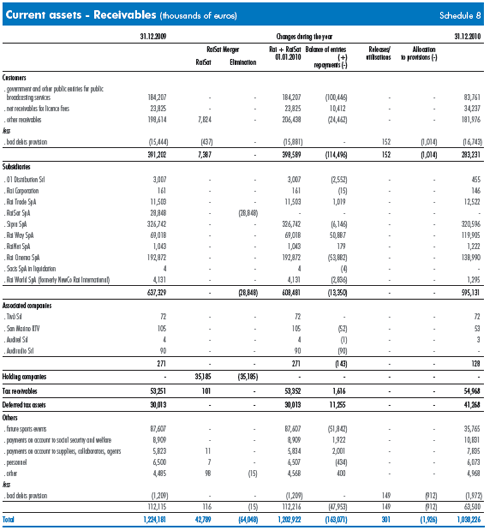
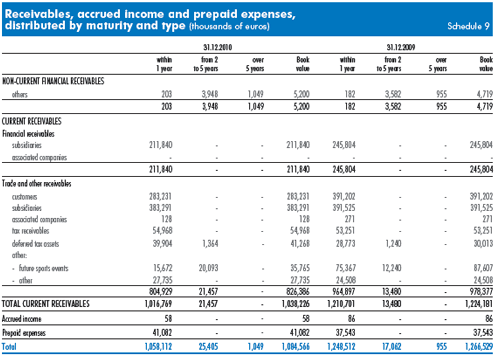
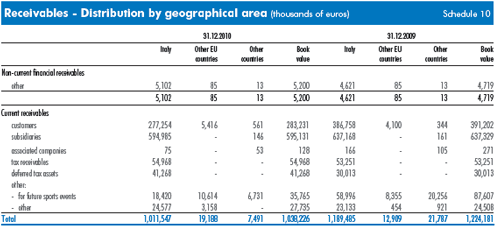
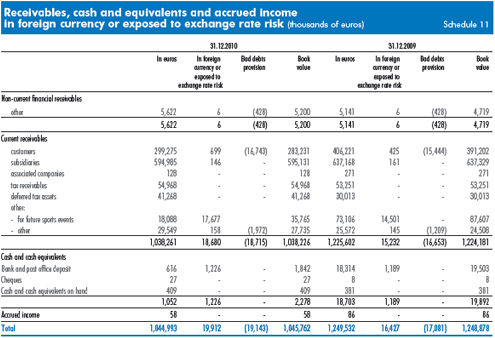
Receivables from customers: these relate to trade receivables, excluding those from subsidiaries and associated companies,
which are carried under separate headings. They total 283,231 thousand euros, with a nominal value of 299,974 thousand
euros which has been written down by 16,743 thousand euros to bring them to their estimated realisable value. Compared
with 31 December 2009, they show a decrease of 107,971 thousand euros.
Details of the caption are divided into:
• receivables for public broadcasting services to central government and other public entities: as shown in the following table,
these amount to a nominal 83,761 thousand euros, down 100,446 thousand euros on 31 December 2009, equivalent
to the balance between the increase in invoices issued and for amounts accrued for 2010 less collections.
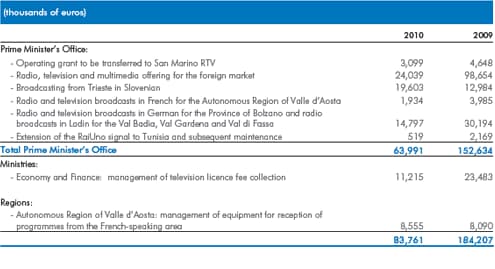
The following should be noted in connection with the above receivables:
- Prime Minister's Office: receivables for television, radio and multimedia broadcasts abroad in Slovenian, French, German
and Ladin relate to services rendered in 2010;
- Ministry for the Economy and Finance: in relation to the management of television licence fee collection, the receivable
refers only to 2010;
- Autonomous Region of Valle d'Aosta: the receivable of 8,555 thousand euros relates to the reimbursement of costs
incurred for the operation of equipment for the reception of French-language programmes for the years from 1994 to
2010.
• Net receivables for licence fees: these amount to 34,237 thousand euros, up 10,412 thousand euros on 31 December
2009, representing licence fees not yet transferred to Rai. Activities are underway to recover such receivables. They consist
in asking the Ministry of the Economy and Finance to increase the specific provision of the expense section during the
settlement of the Government Financial Statements for 2011, in order to allow recovery, with liquidation of the fourth
instalment of transfer of the fees, envisaged to take place in December 2011.
• Other receivables: these amount to nominal value 181,976 thousand euros, down 16,638 thousand euros on 31
December 2009. They relate to the sale of rights, technical assistance to third parties etc..
Receivables from subsidiaries: these amount to 595,131 thousand euros (at 31 December 2009: 637,329 thousand
euros). They represent the year-end balance of transactions with subsidiaries, as shown in Schedule 8. They include financial
receivables of 211,840 thousand euros (245,804 thousand euros at 31 December 2009) and non-financial receivables of
383,291 thousand euros (391,525 thousand euros at 31 December 2009).
Receivables from associated companies: these amount to 128 thousand euros (at 31 December 2009: 271 thousand
euros) and represent the balance of non-financial transactions with Tivù (72 thousand euros), San Marino Rtv (53 thousand
euros) and Auditel (3 thousand euros).
Tax receivables: these are carried at nominal value of 54,968 thousand euros (53,251 thousand euros at 31 December
2009). They comprise 46,144 thousand euros for the balance of Group VAT credits, 6,560 thousand euros for tax refunds
requested (including credit for IRES following the introduction of law which made the IRAP paid during previous tax years partly
deductible), credit for IRAP for the year of 2,141 thousand euros and the remainder relating to minor items.
Deferred tax assets: these total 41,268 thousand euros and represent the credit deriving from items subject to deferred
deductibility for tax purposes, as explained more fully in the section dealing with income taxes, for 41,143 thousand euros, in
addition to which there are items transferred from Group companies participating in the consolidated taxation arrangement.
Details of deferred tax assets, regarding movements in 2010, are provided in the following table:
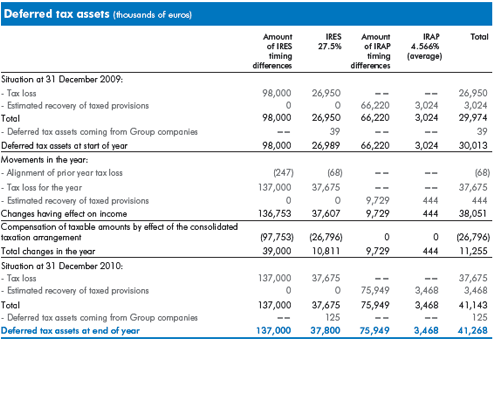
Receivables from others: these amount to 63,500 thousand euros (at 31 December 2009: 112,115 thousand euros). Net
of writedowns of 1,972 thousand euros, they reflect the value of other types of receivable as described below:
• advances to suppliers on sports events filming rights, carried at nominal value of 35,765 thousand euros;
• advances to Social Security institutions on contributions payable for artistic activities and advances on the severance pay,
carried at nominal value of 10,831 thousand euros;
• miscellaneous advances to suppliers carried at nominal value of 7,835 thousand euros;
• receivables from personnel carried at nominal 6,073 thousand euros. They are entirely composed of advances of various
types, mainly for travel expenses (2,371 thousand euros) and production expenses (1,396 thousand euros);
• receivables from the European Union for subsidies and grants for nominal 422 thousand euros, consisting entirely of
receivables for research projects;
• receivables from others, carried at nominal value of 4,546 thousand euros.
Cash and cash equivalents
These are listed in Schedule 12 and comprise:
• Bank and post office deposits: these amount to 1,842 thousand euros (at 31 December 2009: 19,502 thousand euros).
They represent sight or short-term balances on deposit or current account with banks, financial institutions and the Post
Office.
• Cheques: these amount to 27 thousand euros (at 31 December 2009: 9 thousand euros).
• Cash and cash equivalents on hand: these amount to 409 thousand euros (at 31 December 2009: 381 thousand euros)
and include liquid funds in the form of cash and equivalent instruments (duty stamps, cashier's cheques or bank-guaranteed
cheques etc.) held by the Company at 31 December 2010.
Schedule 11 gives a breakdown of the caption in euros and other currencies and Schedule 24 shows amounts at banks and
the Post Office held with Group companies and restricted by attachments.

Accrued income and prepaid expenses
Accrued income and prepaid expenses total 41,140 thousand euros. They are detailed in Schedule 13.
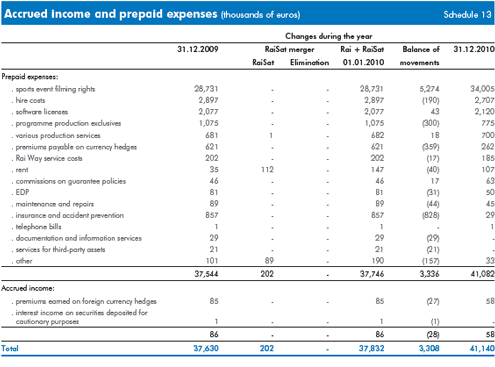
Liabilities
Shareholders' equity
Shareholders' equity totals 374,802 thousand euros.
The components of Shareholders' equity and the effects of operations carried out in 2010 and the previous year are shown
in Schedule 14.
Schedule 15 presents the classification of the Shareholders' equity items on the basis of their origin, possibility of use and
distribution, as well as their use during the previous three years.
The notes indicated hereunder provide further details on the contents of the individual items.
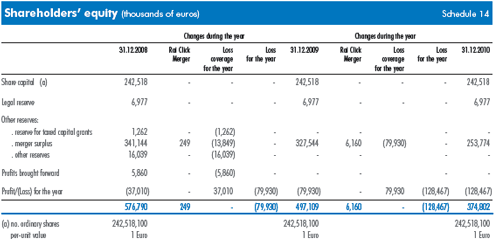
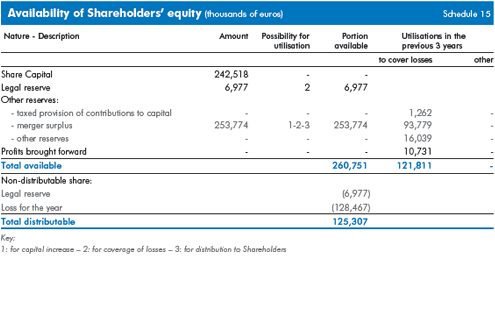
Share Capital
At 31 December 2010 the share capital was represented by 242,518,100 ordinary shares with a par value 1 euro each,
owned by the Ministry of the Economy and Finance (241,447,000 shares, equal to 99.5583% of the share capital) and SIAE,
the Italian Association of Authors and Publishers (1,071,100 shares, equal to 0.4417% of share capital).
Legal Reserve
The legal reserve amounts to 6,977 thousand euros.
Other reserves
Other reserves total 253,774 thousand euros which refer entirely to the merger surplus. The merger by incorporation of RaiSat
determined the booking of a merger surplus of 6,160 thousand euros, broken down as follows:

Loss for the year
This amounts to 128,467,320.38 euros.
Provisions for risks and charges
These amount to 387,749 thousand euros, down 9,834 thousand euros net on 31 December 2009. The composition of
these items and details of the decrease are shown in Schedule 16. The notes which follow provide additional information on
the individual provisions.
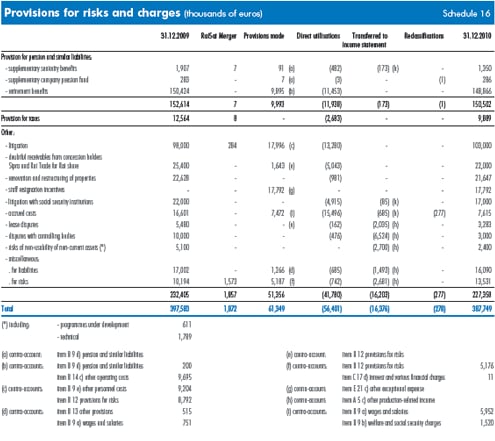
Provision for pension and similar liabilities: this amounts to 150,502 thousand euros and comprises the supplementary
seniority benefits provision, the retirement benefits provision and the company supplementary pension fund.
• The provision for supplementary seniority benefits amounts to 1,350 thousand euros (at 31 December 2009: 1,907
thousand euros). It represents the liability in respect of indemnities in lieu of notice towards employees hired before 1978
who have reached the compulsory retirement age. The amount is revalued each year for consumer price inflation. In the
event of early termination of employment, or changes in category, the amounts accrued are released.
• The provision for retirement benefits amounts to 286 thousand euros (at 31 December 2009: 283 thousand euros),
includes amounts accrued until 31 December 1988 and supplementary amounts allocated in subsequent periods in order
to protect the real value of the provision for eligible employees in accordance with the terms of the national collective
labour agreement.
Since 1 January 1989 retirement benefits paid by Rai and withholdings from employees have been paid into CRAIPI (supplementary
retirement fund for Rai employees) and FIPDRAI (supplementary retirement fund for Rai managers), associations
which are responsible for managing retirement funds under the agreements entered into between Rai and the trade unions.
Upon retirement, the funds accumulated by Rai, CRAIPI and FIPDRAI are paid out unless employees opt, at the time they
obtain the pension rights, to obtain equivalent life annuities. In this case, the Rai, FIPDRAI and CRAIPI funds remain with
the associations to finance the said life annuities.
• The provision for supplementary seniority benefits amounts to 148,866 thousand euros (at 31 December 2009: 150,424
thousand euros). It includes:
- 139,638 thousand euros for supplementary pension benefits currently being paid (at 31 December 2009: 141,396
thousand euros) consisting of funds accrued for employees who have opted for the supplementary pension plan under
the trade union agreements, which are kept at an adequate level to ensure said benefits, with respect to actuarial
reserves;
- 9,228 thousand euros (at 31 December 2009: 9,028 thousand euros) for supplementary pensions that will be paid to
eligible managerial staff still in service in the event that some of these opt for the supplementary pension plan. Benefits are
calculated on the basis of pay earned, seniority and financial and demographic parameters normally used in similar cases.
The provision for current and deferred taxes amounts to 9,889 thousand euros (at 31 December 2009: 12,564 thousand
euros). The following table shows a breakdown of the item and changes during 2010.
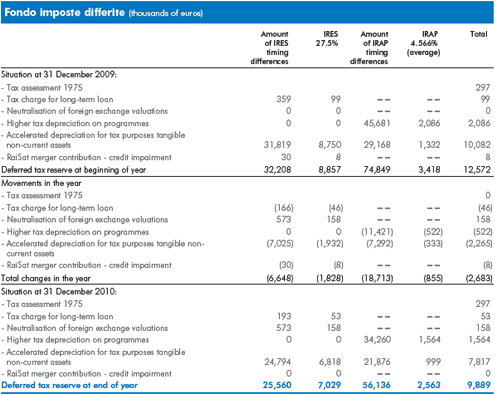
Other provisions: these amount to 227,358 thousand euros (at 31 December 2009: 232,405 thousand euros). They include
provisions for costs or losses the existence of which is certain but the amount of which cannot be exactly determined, or
which are probable and the amount of which can be reasonably estimated. The main items are detailed in Schedule 16. As
regards pending litigation with employees and third parties, the amount carried in the provisions for liabilities and risks is the
best estimate of the likely liability based on the most up-to-date information available.
Provision for staff severance pay
The provision totals 305,142 thousand euros (at 31 December 2009: 322,351 thousand euros). The provision for staff
severance pay is determined at individual level in accordance with the provisions of art. 2120 of the Italian Civil Code,
complemented by the Finance Law 2007 (Law 296 of 27 December 2006), which established the entry into force of the new
legislation on pension funds (Legislative Decree 252 of 5 December 2005) as 1 January 2007.
By effect of this legislation, provisions for staff severance pay converge into pension funds other than those inside the company,
unless employees ask to maintain the severance pay within the company: In this case, the provisions are paid into a reserve
managed by the INPS, which will transfer to the company all the benefits disbursed by the latter in the event of payment of
advances or termination of the employment contract, as envisaged by Article 2120 of the Civil Code.
The composition of the provision and changes during the year are shown in Schedule 17.

Payables
These amount to 1,055,463 thousand euros, down 67,424 thousand euros on 31 December 2009.
More specifically, financial debt to banks totals 147,979 thousand euros, with a net decrease of 15,755 thousand euros on
the figure disclosed in the 2009 financial statements. No payables covered by collateral in the form of company assets are
recorded.
A breakdown of the caption and the contribution deriving from the merger with RaiSat is given in Schedule 18, while Schedules
19 and 20 show the composition of payables by maturity, type and currency.
With regard to geographic distribution, about 86% relates to Italian residents and about 12% relates to non-EU residents.
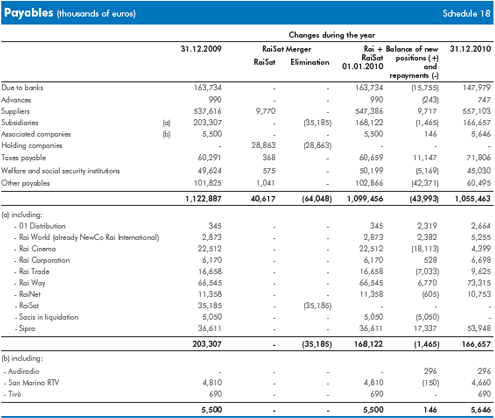
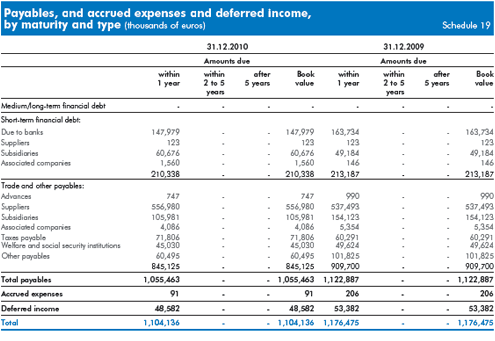
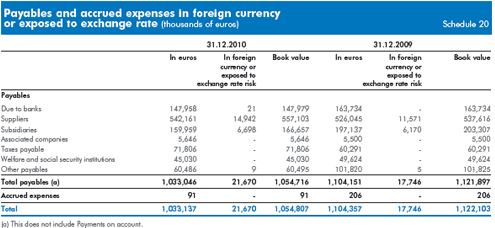
The notes indicated hereunder provide further details on the contents of the individual items.
Due to banks: these amount to 147,979 thousand euros (at 31 December 2009: 163,734 thousand euros), representing
the negative balance of current account overdrafts with certain banks.
Advances: these amount to 747 thousand euros (at 31 December 2009: 990 thousand euros) relating entirely to miscellaneous
advances.
Due to suppliers: amounts to 557,103 thousand euros (at 31 December 2009: 537,616 thousand euros) and shows an increase
of 19,487 thousand euros with respect to the figure disclosed for the previous year. They consist of 123 thousand euros
in financial debts (unchanged from 31 December 2009) and 556,980 thousand euros in commercial debts (31 December
2009: 537,493 thousand euros).
Accounts payable to subsidiaries: amount to 166,657 thousand euros (at 31 December 2009: 203,307 thousand euros),
as detailed in Schedule 18. They include financial debt for 60,676 thousand euros (at 31 December 2009: 49,184 thousand
euros) and non-financial payables of 105,981 thousand euros (at 31 December 2009: 154,123 thousand euros).
Accounts payable to associated companies: amount to 5,646 thousand euros (at 31 December 2009: 5,500 thousand
euros), as detailed in Schedule 18. They include financial debt for 1,560 thousand euros (at 31 December 2009: 146 thousand
euros) and non-financial payables of 4,086 thousand euros (at 31 December 2009: 5,354 thousand euros).
Taxes payable: these amount to 71,806 thousand euros (at 31 December 2009: 60,291 thousand euros) and show an
increase of 11,515 thousand euros with respect to the figure disclosed for the previous year. They consist of:
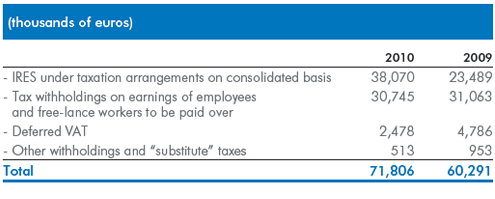
As regards debt in relation to IRES, as reported in the accounting policies, the company has opted for group taxation, transferring
to itself, as the consolidating entity, the activities inherent in the liquidation and payment of the tax with regard to the
following companies: 01 Distribution, Rai World (formerly NewCo Rai International), Rai Cinema, Rai Way, RaiNet, Sipra and
Rai Trade, within the consolidated taxation arrangement. For 01 Distribution, Rai World (formerly NewCo Rai International),
Rai Cinema, Rai Way and RaiNet the entitlement to make use of the consolidation tax arrangement has been renewed until
financial year 2012; for Sipra, for which the last financial year available for use of this arrangement is 2010, the option will
be renewed until 2013 within the terms envisaged.
Welfare and social security institutions: these payables amount to 45,030 thousand euros (at 31 December 2009: 49,624
thousand euros). They reflect contributions due on remuneration paid to employees and consultants, to be paid over to the
institutions at the scheduled dates. They consist of:
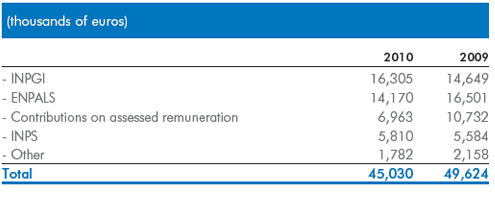
Other payables: these amount to 60,495 thousand euros (at 31 December 2009: 101,825 thousand euros), and show a
net decrease of 41,330 thousand euros on the previous year, as follows:
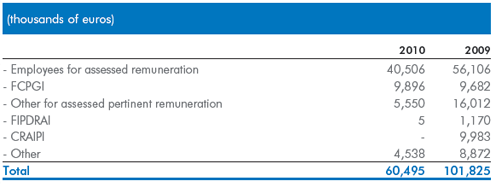
Accrued expenses and deferred income
This caption totals 48,673 thousand euros. Details and a comparison with the previous year are provided in Schedule 21.
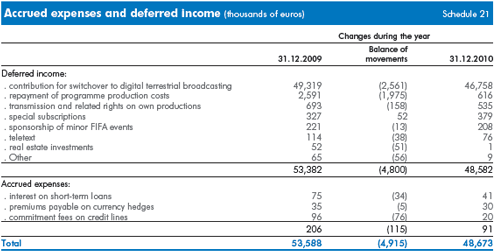
The caption contains the entire amount contributed of 46,758 thousand euros, net of the amount already booked to the
income statement, disbursed by the Ministry for Communications in support of initiatives to accelerate the switch-over to the
digital terrestrial platform, consisting of operations on systems and adaptation of the site infrastructures to extend areas covered
by the digital signal and improve reception and the quality of service perceived by the user.
The task of making the necessary investments is entrusted to the subsidiary Rai Way SpA, which is also responsible for the
design, installation, construction, maintenance, implementation, development and operation of the telecommunications networks.
The contribution is disclosed in the income statement of each year in relation to amortisation booked by the subsidiary, taking
into account the relationship between the amount of contributions collected and the total investments envisaged for the
accomplishment of related projects.
5) Memorandum accounts
Memorandum accounts amount to 537,193 thousand euros. A breakdown by type is provided in the table attached to the
Parent Company balance sheet and they are analysed in detail in Schedules 22, 23 and 24.
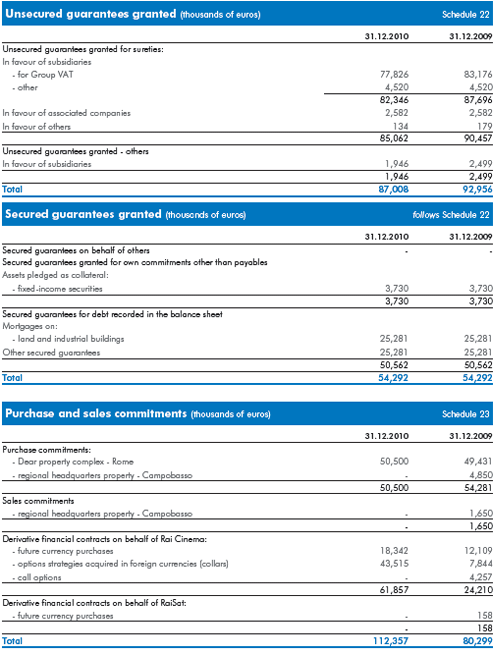
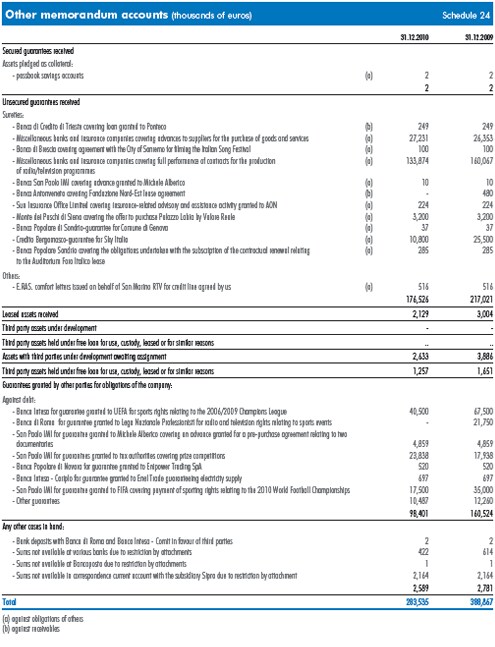
The terms of the hedge contracts covering the specific company commitments or those taken on for the subsidiary Rai Cinema
SpA relating to fair value are summarised in Schedule 25. The fair value of these instruments is determined with reference to
the market value on the closing date of the period under assessment; in the case of unlisted instruments, fair value is determined
using commonly used financial evaluation techniques.
On the whole, hedging contracts entered into are, in observance of the Group policy, of a reasonable amount in relation to
the overall extent of the commitments subject to such risks.
The purchase commitments also include the DEAR property complex, with a value of 50,500 thousand euros, transferred in 2011.
At 31 December 2010 there were no commitments, other than those highlighted among the memorandum accounts, of
particular significance for the purchase or sale of goods and services in addition to those taken on in the normal course of
business that would require specific information to be given for a better understanding of the Company's financial position.
Schedule 24 details the amount of company assets held by third parties for the various reasons indicated therein.
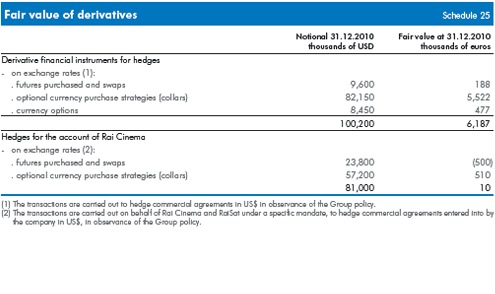
6) Income Statement
Production value
Revenues from sales and services: these amount to 2,740,323 thousand euros (at 31 December 2009: 2,895,617 thousand
euros). They basically include revenues pertaining to the year from licence fees and advertising. A breakdown into major
components is given in Schedule 26. As can be seen from the distribution of revenues by geographic area, they almost all
originate in Italy.
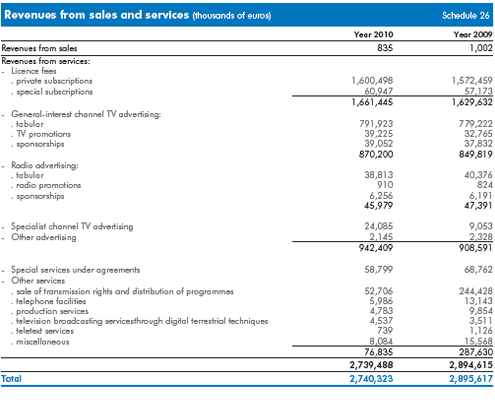
As regards revenues from licence fees, the mechanism used to determine the per-unit fee envisaged by the Consolidated
Broadcasting Law ("separate accounting"), aimed at guaranteeing the proportions between costs sustained by Rai, and certified
by an independent auditor, for the performance of its public service remit and resources from licence fees, highlights a
lack of the latter for the period from 2005 to 2009, totalling over 1.3 billion euros, of which more than 300 million euros
refers to 2009 alone. For 2010, the "separate accounting" figures will be available, as established, within four months of the
date on which the Shareholders' Meeting approves the financial statements.
Changes in inventories of work in progress, semi-finished and finished goods: these amount to 59 thousand euros (at
31 December 2009: 6 thousand euros). They are entirely attributable to the increase in the value of inventories associated
with the books publishing and periodicals business.
Internal cost capitalisations: the amount of 14,200 thousand euros (at 31 December 2009: 15,418 thousand euros) represents
internal costs associated with non-current assets, which were capitalised under the specific asset captions. Details are
shown in Schedule 27.

Other production-related income: this amounts to 131,492 thousand euros (at 31 December 2009: 124,642 thousand
euros), as detailed in Schedule 28.
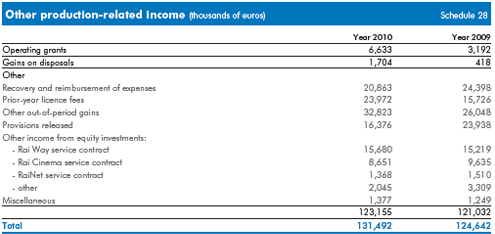
Production costs
This caption comprises costs and losses related to ordinary activities, excluding financial operations. The costs shown here do
not include those relating to non-current tangible and intangible assets, which are recorded under the respective asset accounts.
Raw materials, supplies, consumables and merchandise: these total 22,703 thousand euros (at 31 December 2009:
23,054 thousand euros), which includes purchases of technical materials for inventory - excluding items used in the construction
of plant, which are allocated directly to non-current tangible assets - production materials (sets, costumes etc.) and miscellaneous
operating materials (fuel, office supplies, printed documents etc.), net of discounts and allowances, as shown in Schedule 29.

Services: these amount to 811,621 thousand euros (at 31 December 2009: 838,302 thousand euros) and comprise costs
for freelance workers and other external services, net of discounts and allowances, as shown in Schedule 30.
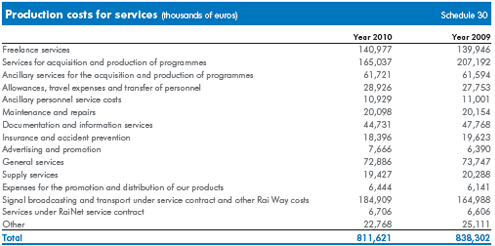
Among other things, they include emoluments, remuneration for special functions, attendance fees and reimbursement of
expenses paid to Directors for 2,186 thousand euros and to Statutory Auditors for 196 thousand euros. To provide a complete
picture of the situation, following the merger by incorporation of RaiSat SpA into Rai SpA, the caption discloses costs of 17
thousand euros for the directors of the incorporated company and of 32 thousand euros for statutory auditors.
They also include 188 thousand euros of annual fees for the statutory audit by independent auditors, 38 thousand euros for
other auditing services, and 15 thousand euros for other non-audit services.
Use of third-party assets: these amount to 827,564 thousand euros (at 31 December 2009: 910,058 thousand euros), and
express costs for rents, leases, usage rights and filming rights, as detailed in Schedule 31.

Personnel costs: employee-related costs amount to 911,045 thousand euros (at 31 December 2009: 903,548 thousand
euros), broken down as indicated in the income statement. The average number of employees on the payroll in 2010 was
11,857, including employees on fixed-term contracts, as detailed in Schedule 32.
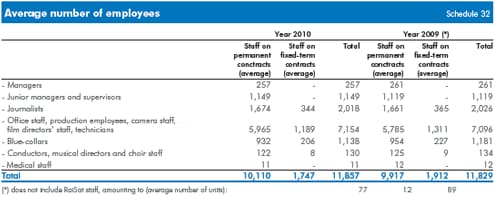
Amortisation, depreciation and writedowns: these amount to 374,644 thousand euros (at 31 December 2009: 378,459
thousand euros). The breakdown is shown directly in the income statement. In detail, amortisation in relation to intangible assets
refers basically to industrial patents and intellectual property rights for 270,009 thousand euros (at 31 December 2009:
273,433 thousand euros), while Schedules 33 and 34 provide details of depreciation of tangible assets and writedowns in
relation to non-current assets. They include a writedown of capitalised programmes amounting to 28,986 thousand euros,
which was made to take account of the risk that certain programmes may not be transmitted or re-broadcast.

Changes in inventories of raw materials, supplies, consumables and merchandise: the amount of 241 thousand euros
(at 31 December 2009: minus 93 thousand euros) represents the increase in net inventories carried under current assets at
31 December 2010 with respect to the previous year.
Provisions for risks: these amount to 15,611 thousand euros (at 31 December 2009: 27,569 thousand euros) and indicate
allocations to provisions for risks. The most significant items are detailed in Schedule 16.
Other provisions: these amount to 515 thousand euros (at 31 December 2009: 1,740 thousand euros). The main items
are shown in Schedule 16.
Other operating costs: these amount to 82,903 thousand euros (at 31 December 2009: 97,046 thousand euros). Their
composition is shown directly in the income statement and further information is provided in Schedule 35.
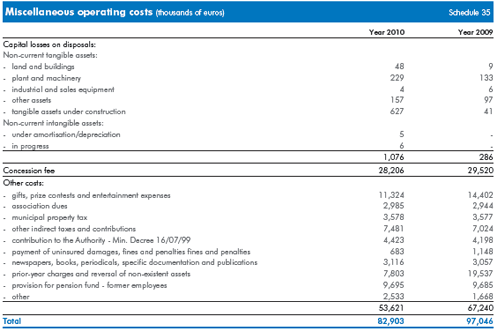
Financial income and expense
Income from equity investments: this amounts to 62,407 thousand euros (31 December 2009: 49,763 thousand euros),
and is represented by 57,643 thousand euros of dividends distributed in 2010 by investee companies, and 4,764 thousand
euros of capital deriving from the completion of the liquidation of Sacis SpA, as shown in Schedule 36.
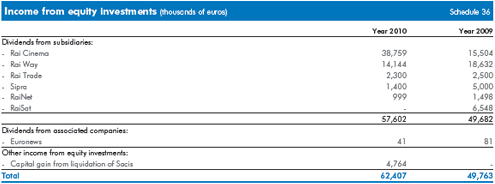
Other financial income: this amounts to 4,605 thousand euros (at 31 December 2009: 5,412 thousand euros) broken
down as follows:
• from non-current receivables: booked for 11 thousand euros for interest income on cautionary deposits;
• from non-current securities other than equity investments: booked for 73 thousand euros and referring to interest earned;
•financial income other than the above: this amounts to 4,521 thousand euros and mainly relates to interest on current
receivables as shown directly in the income statement and detailed even further in Schedule 37.
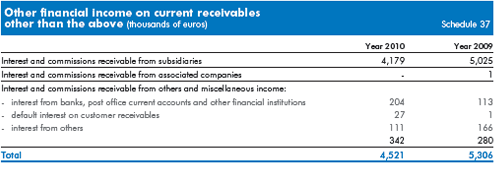
Interest and other financial expenses: these amount to 5,072 thousand euros (at 31 December 2009: 4,914 thousand
euros). They relate to interest expense, commission expense for financial services received and other charges for financial
operations, as shown directly in the income statement and in further detail in Schedule 38.

Foreign exchange gains and losses: these show a gain of 2,401 thousand euros (at 31 December 2009: 806 thousand
euros), representing the balance of foreign exchange charges and premiums on foreign currency hedge transactions as well
as the effect of translating the value of payables and receivables in foreign currencies at year-end exchange rates or the rate
in force at the time of the hedge in the case of exchange risk hedges, as detailed further in Schedule 39.

Value adjustments to financial assets
Revaluations: these amount to 465 thousand euros (at 31 December 2009: 199 thousand euros). They reflect the recovery
of losses incurred by subsidiaries in previous years.
Writedowns: these total 3,062 thousand euros (at 31 December 2009: 2,133 thousand euros). They comprise writedowns
of non-current financial assets following losses incurred for the year.
Exceptional income and expense
The caption is comprised of charges of 45,470 thousand euros and income of 415 thousand euros and is analysed in Schedule 40.

Current income taxes for the year, and deferred tax assets and liabilities
These amount to 15,134 thousand euros. They are made up as follows:

The following table shows the origin and effects of deferred tax items during the year.
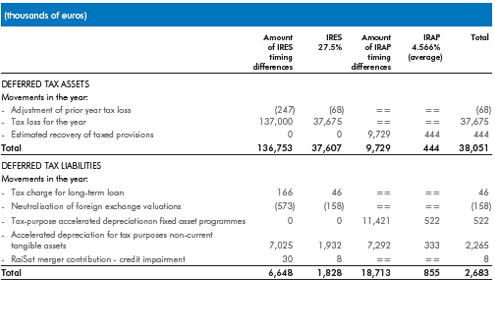
The following table presents the estimated reconciliation between the statutory result for the year and the taxable amount for
IRES and IRAP purposes.
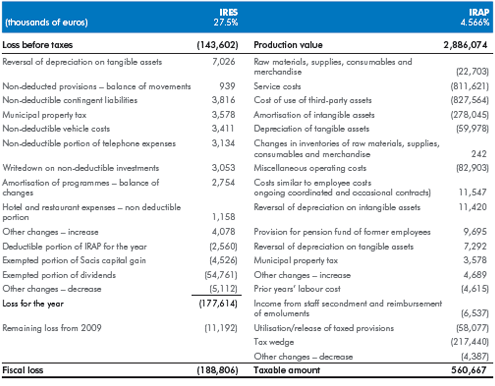
On the taxable amount for IRAP, current taxes of 25,600 thousand euros have been calculated.
7) Result for the year
The year closed with a loss of 128,467,320.38 euros.
8) Other information
As regards disclosures on related parties, no significant transactions took place outside the normal market conditions. For
details on relations with Group companies, see the Report on Operations.
By rulings no. 2379/2010 of 28 October 2010 (filed on 9 December 2010) and 326/2011 of 15/18 November 2010 (filed
on 23 February 2011), the Court of Auditors - Jurisdictional Section for the Lazio Region - ordered payment to Rai for state
tax damages by certain parties including executives and members of the Board of Director of Rai. Despite these rulings being
immediately enforceable, subject to suspension following appeal, uncertainties exist in relation to possible subsequent developments
in court. Owing to this the conditions no longer obtain for recording an account receivable.
For important events occurring after the closing date, see the Report on Operations.
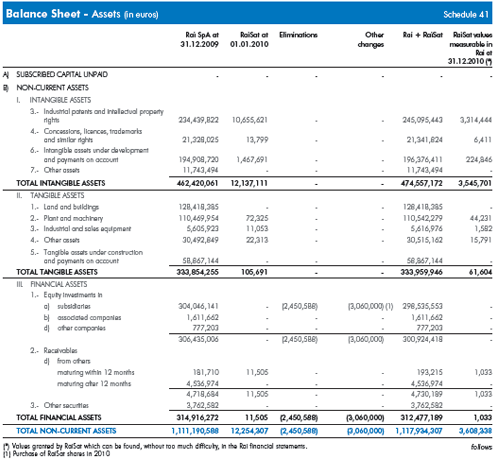
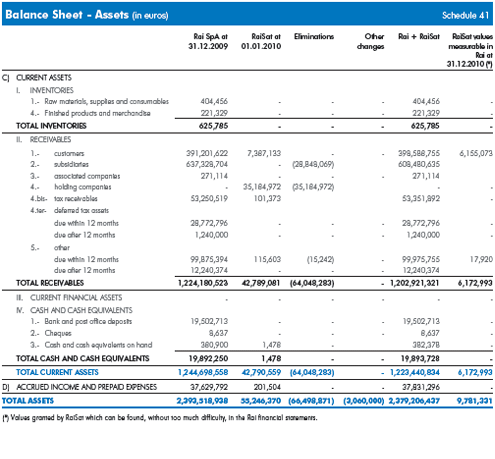
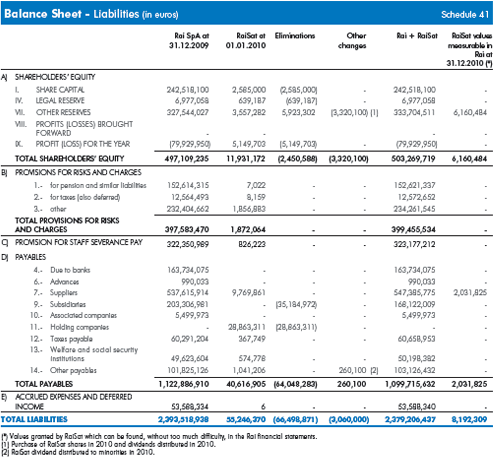
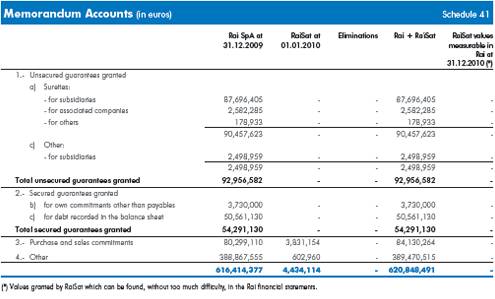
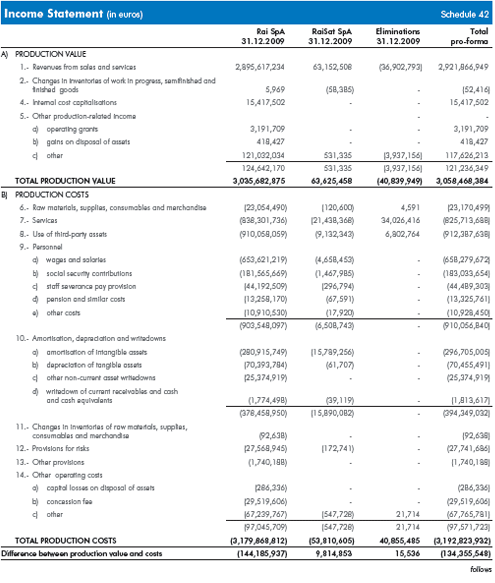
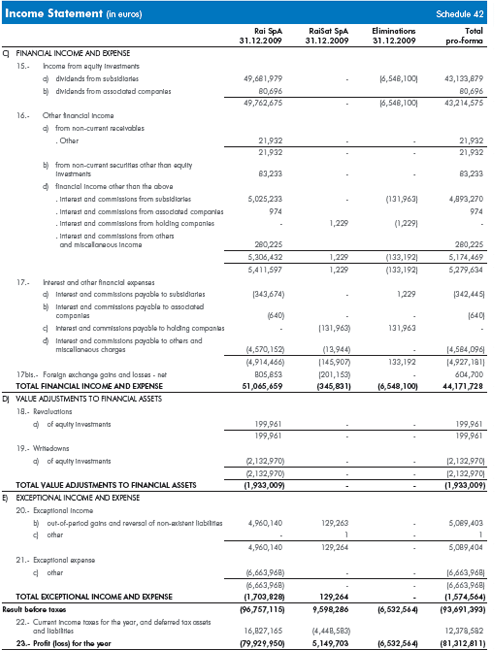
 |
 |